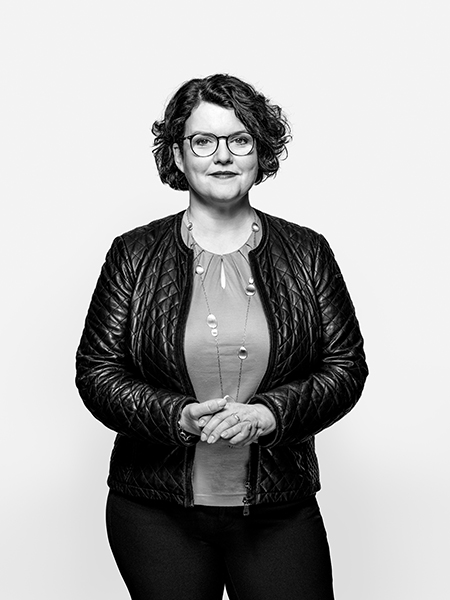Why Does It Pay to Focus on Sustainability?
Product Stewardship/Sustainable Chemistry
Why Does It Pay to Focus on Sustainability?
Sustainability is a pillar of Clariant’s business strategy. Substantiating and quantifying claims about how a certain product helps customers perform more sustainably is a key. It’s not always straighforward, however. With EcoTain®, Clariant has taken out the guess work. Not only about the environmental and social benefits of products, but also their economic impact and the shift in customer demand.
External Expert Interview
Isolde Bachert
As Head of Research & Development at Follmann, Isolde works on ways to measure and promote sustainability benefits across Follmann’s portfolio.
Read the interviewWhat helps to market sustainability?

Isolde, you manage Research & Development at Follmann. What’s your relationship to Clariant as a supplier?
They supply some of our most essential materials, but not only that. We’ve come to value them for their innovative products and the way we work together on a technical level. It’s a great partnership – one that we’re expanding.
You’re talking about plans to jointly promote the Clariant EcoTain® label. What’s the idea behind that?
Sustainability has been a defining trend for us and our industry for some time. But recently, what our customers ask from us has become a lot more specific. Delivering quantifiable benefits in terms of sustainability now is a big selling point for us. That’s something the EcoTain® label helps us with.
Who is driving this trend?
Consumers are the driving force. Follmann specializes in printing inks, coatings, and adhesives. So while consumers aren’t our direct customers, we deal with consumer goods companies, the packaging industry, and furniture manufacturers. Printing and bookbinding are also big markets for our inks and adhesives. All these industries face a certain amount of consumer pressure in terms of sustainability. Initially, that was all about energy consumption and CO? emissions, but companies are increasingly taking other factors into account. Many companies made big commitments to using only renewable materials.
How big is that impact though, when there’s just so little ink on a piece of packaging?
It might be small in comparison, but it adds up. Take our water-based inks. They replace the need for organic solvents. That way the drying process doesn’t emit organic compounds that you’d have to collect and burn off. There were times when nobody cared too much whether that added a little to the overall carbon footprint. Those times are over.
EcoTain® uses a methodology to quantify these kinds of benefits. What’s special about that?
Clariant was the first supplier to come to us with the idea. I like that they use a wide range of criteria that are near and dear to our customers. Also, EcoTain® doesn’t just look at a product by itself. Instead, it analyzes the specific application and how that measures up to common alternatives. That helps make a convincing argument for our solution. Additionally, applying that same methodology across our whole portfolio helps us see which products are set to do well and which might face problems when regulations or customer demands intensify.
What are some of your products that carry the EcoTain® label?
One is a glue that’s used in book binding. Its main ingredient is an EcoTain® product that’s based on renewable materials. Another product like this goes into glues for cardboard packaging.
And does Follmann plan to further apply the EcoTain® methodology?
The first step is to look for products that rely or could rely on EcoTain® materials. But then we expand this view and look to apply the same criteria to other products and ingredients. In the end, we’ll want to quantify how well our products address what is most important to our customers – be it renewable materials, CO? reduction, energy savings, water use, or whatever. That goes for our current portfolio as well as innovation, whenever we’re evaluating if an R&D project is worth pursuing.
Will you be making use of the EcoTain® methodology with other suppliers?
Absolutely. But that’s along the lines of what we’re seeing already. Our customers ask more and more detailed questions about what goes into our products. A supplier that can’t or won’t help us answer those questions won’t be a supplier for long.
Internal Expert Interview
Lynette Chung
As Head of Corporate Sustainability Strategy & Advocacy at Clariant, Lynette helps businesses better promote and market sustainable products.
Read the interviewWho benefits from labeling sustainable products?

Lynette, how would you describe EcoTain® to the uninitiated?
The short answer: It’s Clariant’s brand for products and solutions that have outstanding sustainability advantages, don’t compromise on performance, and benefit customers, the value chain, and society as a whole.
What’s the long answer?
EcoTain® is a way to distinguish our sustainability offering from the mainstream. It sets an ambitious benchmark for our aspirations. Each product carrying the EcoTain® label has undergone a systematic, in-depth screening process using 36 criteria, which consider the overall product life cycle and value chain. The criteria are forward looking, developed and tested with customers, NGOs and other stakeholder groups, establishing a solid approach. Only exceptional products that significantly exceed market standards, with a best-in-class performance in one or several of the 36 criteria, are awarded the EcoTain® label by the corporate EcoTain® panel that scrutinizes each application.
EcoTain® as a company-wide label was born in 2015. Why does it make sense to have a universal set of criteria across so many different products and markets?
It helps to have a common understanding of what sustainability really means at the product level in the company. There are always broad claims in every market about what is a sustainable solution and what isn’t. Using the same criteria across the board lets us validate and quantify our claims. This is very important in order to have a strong, credible brand that customers but also we ourselves can relate to. That’s something our Business Units appreciate.
Has this common understanding changed the discussion about sustainability within the company?
It has. Our Business Units and their markets face different requirements and challenges. But lately, we’ve seen an overall shift that’s not just due to our corporate focus on sustainability – it is more business- and market-driven. Having a sustainability brand, ensures visibility of our efforts in the market place. Internally, it drives progress as it also creates internal competition. Our Business Units take pride in having an EcoTain® portfolio and growing it. We now also systematically use our sustainability criteria in screening major Research & Development projects.
How many products carry the EcoTain® label?
As we speak, we have 193 EcoTain® products. EcoTain® products exist in all of our Business Units.
Do you track how well EcoTain® products are doing economically?
Absolutely! That’s one of the big questions. What kind of value are they adding – apart from, of course, the environmental and societal contribution?
And what are you seeing?
Sales in our EcoTain® products overall are growing significantly faster than the rest of our portfolio, at a double-digit growth rate, which is excellent. In addition, margins for EcoTain® products are typically stronger. The higher growth rates and profitability clearly demonstrate the business case for sustainability.
What does that tell you?
It tells us that markets really are shifting towards more sustainable solutions. And we have an opportunity to use sustainability as a driver for innovation and in marketing.
Were there doubts about that?
Maybe not doubts. We all believe that markets are shifting and are increasingly sensitive to sustainability, but having done this exercise and having actual proof of how it’s affecting our bottom line is very rewarding and convincing.
Have you seen other kinds of recognition?
We’ve received a few awards and great feedback on our approach from stakeholders, such as NGOs, policy-makers, and peers. The greatest and most recent recognition comes from some customers that have asked to highlight the EcoTain® ingredients in their own products with the EcoTain® label. This is tremendous! But I think we’re still not quite where we want to be. There’s still some way to go in promoting EcoTain®, advocating change, policy and market shifts to bring more customers and markets with us on our sustainability journey.